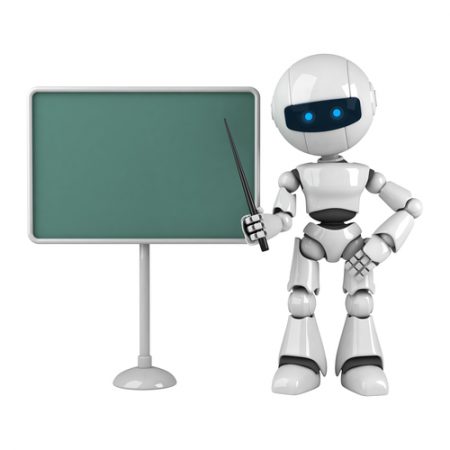April 12, 2017 – Roy Rasmussen, has been a guest contributor to 21st Century Tech Blog on four previous occasions. He is a coauthor of Publishing for Publicity, a freelance copywriter, and a specialist in helping businesses reach target markets through focused sales messages. He has written books on cloud computing, small business management, sales, business coaching, social media marketing, and career planning. Today his focus is on the impact on teachers with the growing presence of artificial intelligence (AI). Will a teacher stand at the head of the class in the next few decades, or will automation combined with AI render them obsolete? Enjoy the read.
In his 1951 short story “The Fun They Had,” science fiction writer Isaac Asimov envisioned children in the year 2157 being so bored with their mechanical teachers they daydream about the fun kids must have had when they still went to schools with human teachers.
But an essay Asimov penned 25 years later, “The New Teachers,” strikes a more optimistic tone, proposing that future educational challenges be solved by customized teaching machines adjusted for each individual student. Recent technology has taken several steps toward fulfilling that latter vision with former U.S. Education Secretary Arne Duncan pushing for tablets to replace textbooks.
But will technology ever totally replace teachers? Or will human instructors continue to play a significant role in education? Can artificial intelligence (AI) and human teachers co-exist in the classrooms of tomorrow?
AI Advances in Education
One way AI can increase educational efficiency is by taking over routine, rules-based tasks, according to Digital Tsunami author Abhijit Bhaduri. For instance, computers using AI can grade assignments and tests about topics with straightforward answers such as solving math problems.
Meantime, Microsoft founder Bill Gates sees AI as a way to customize learning. Gates has invested millions of dollars in developing personalized learning software that creates lesson plans for students based on their performance and guides them through trouble spots.
Another way AI can improve education is through analytics providing feedback to educators, administrators, and parents, according to big data expert Bernard Marr. For instance, educational software provider Third Space Learning has been working with University College of London, analyzing hundreds of thousands of hours of tutoring data and identifying and imitating patterns that make for good teaching.
The Role of Human Teachers
While these types of technology can help automate many educational tasks, experts agree they are unlikely to entirely replace human teachers and classrooms in the near future. Asimov acknowledged as much, saying machines were unlikely to eliminate human teachers in certain subjects, and Gates concurs that AI is better-equipped to teach mathematics rather than subjects such as writing.
For one thing, AI is geared toward rules-based, deductive tasks, but one function of teaching is helping students inductively discover rules in the first place. This aspect of teaching is more art than science, pivoting around a teacher’s creative insight into how to best present examples and clues in order to trigger student understanding. Thus, while AI may be useful for evaluating how well students can deductively apply memorized formulas and facts, human teachers are better equipped to help students understand inductive insights that underlie rote rules.
Similarly, while AI software programs can analyze students’ past performance and optimize lessons accordingly, they cannot provide the social support of a human teacher or fellow students. As Asimov observed, there is educational value in students interacting with teachers and their peers.
Finally, AI and other technology-based programs can present knowledge that human beings have already learned. They still depend, however, on humans to add new knowledge, and they also depend on human programmers. As Asimov put it, “who will teach the teaching machines?”
How Human and AI Teachers Can Work Together
These factors suggest that the future of education lies with humans and AI working collaboratively rather than the latter replacing the former. AI can handle routine tasks such as:
- Delivering pre-programmed lessons
- Providing answers to frequently asked student questions
- Evaluating standardized tests
- Analyzing trends in student and teacher performance
Relieving teachers of the routine and mundane will free up more time for them to work with individual students in areas in where they struggle or are delinquent. As well human teachers can handle teaching creative and critical reasoning skills not transmitted through rote learning and develop new classroom presentations that fill gaps not covered by automated curricula.
As automation increasingly enters classrooms, cyber security will become a growing classroom issue. Just as hospitals must safeguard patients’ healthcare records, schools will need to secure and provide reliable online backup for student personal information and performance. InBloom, a personalized learning software provider, was recently compelled to close down after parents and privacy advocates expressed concern over potential misuse of student data.









